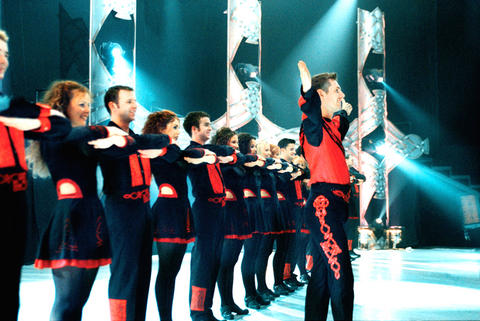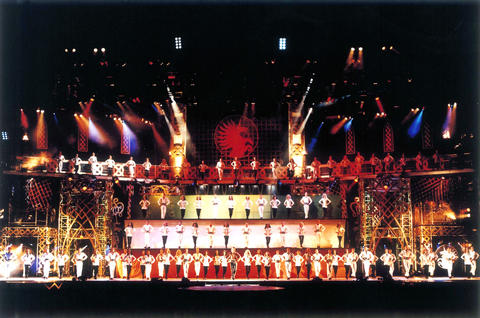Bare chested men in leather pants, women with long tresses and short skirts, lines of dancers stamping in unison - this is the image that Michael Flatley's tap dance extravaganzas evoke. Critics sniff at the shamelessly flashy Vegas-style pageantry and purists are repelled by what is thought to be a bastardized rendering of a once-obscure art form, but millions of fans cheer Flatley's lordly presence. Feet of Flames, recreated for this Taiwan tour nearly 10 years after its legendary premiere in Hyde Park, London, is a dance blockbuster that mixes contemporary choreography, Celtic dance and music with pyrotechnics, explosive visual effects and video displays designed to overwhelm.
Flatley's story is well-known. The son of a Chicago construction contractor who immigrated from Ireland, Flatley was brought up in a house with a solid work ethic and two champion Irish dancers - his mother and grandmother. With an almost manic drive to raise himself up in the world (Flatley once reportedly said that he didn't have time to read anything other than self-help and motivational books) the then-aspiring lad managed to become the first American World Irish Dance Champion at 17. His first big break came when he scored a gig with the Chieftains in the 1980s, which eventually led to an interval act for the 1994 Eurovision Song Contest. The seven-minute prototype of Riverdance performed there was expanded into a full-length production and made Flatley an instant star. Flatley left the production amid a bitter dispute over the copyright of the Riverdance routines and went on to stage The Lord of the Dance in 1996. The rest is history.
Dubbed the turbo-charged reworking of Lord of the Dance, Feet of Flames was created in 1998, following the same storyline but doubling the number of dancers and adding new music, numbers, sets and costumes. The dance spectacle is representative of Flatley's updated and popularized version of traditional Irish step dancing.

PHOTO: COURTESY OF KHAM
Credited to Irish parish priests who developed the dance style due to concerns about lascivious bodily display, step dancing involves a stiff torso and rigidly held arms juxtaposed against quick, precise movements of the feet. In the skillful hands of Flatley, the staid dance was turned into a showbiz spectacular glazed with full-on sexuality and expressive choreography.
For those who aren't familiar with the story, Feet of Flames recounts the perennial tale of the battle between good and evil, represented by the Lord of the Dance and Don Dorcha, the Dark Lord. A lusty romance sub-plot spices things up with Irishwoman Colleen Saoirse winning the heart of the Lord of the Dance from the wicked temptress Morrigan.
Flatley himself will not dance in the Taiwan shows, and the lead role will be played by Damien O'Kane, who played Flatley's original role when Lord of the Dance visited Taiwan in 2004.

PHOTO: COURTESY OF KHAM
According to Yang Yu-tsun (楊玉存) of Kuang Hong Arts (寬宏藝術), restaging Feet of Flames in Taiwan after its world tour ended seven years ago was made possible by the almost insatiable thirst that Taiwanese audiences have for Flatley's shows. Lord of the Dance, which was staged here in 2004 and 2005, and Celtic Tiger a year later, all proved enormously successful.
"When Flatley came with Celtic Tiger in 2006, we suggested the possibility of bringing Feet of Flames to Taiwan since so many people love his shows," Yang said. "After six months of communications and persuasion, Flatley finally agreed to re-stage the production in Taiwan."
The two-hour show has cost over NT$100 million to stage in Taiwan, and every effort has been made to match the grand scale of the original London production. Nearly 100 dancers will sashay, prance and leap on the multi-tiered stage against displays of pyrotechnics and rear-screen projections. Around 20 crew members have been flow in from the UK to construct the set with the aid of local theater technicians. The troupe has been rehearsing intensively in Kaohsiung for the last two weeks, but requests for interviews were rejected.

PHOTO: COURTESY OF KHAM
Performances in Taipei and Taichung are nearly sold out. Tickets for the Kaohsiung and Tainan shows are selling quickly. Flatley may have taken his last curtain call as the Lord of the Dance, but the show he created and continues to direct still works box office magic.

PHOTO: COURTESY OF KHAM

This month the government ordered a one-year block of Xiaohongshu (小紅書) or Rednote, a Chinese social media platform with more than 3 million users in Taiwan. The government pointed to widespread fraud activity on the platform, along with cybersecurity failures. Officials said that they had reached out to the company and asked it to change. However, they received no response. The pro-China parties, the Chinese Nationalist Party (KMT) and Taiwan People’s Party (TPP), immediately swung into action, denouncing the ban as an attack on free speech. This “free speech” claim was then echoed by the People’s Republic of China (PRC),

Exceptions to the rule are sometimes revealing. For a brief few years, there was an emerging ideological split between the Democratic Progressive Party (DPP) and Chinese Nationalist Party (KMT) that appeared to be pushing the DPP in a direction that would be considered more liberal, and the KMT more conservative. In the previous column, “The KMT-DPP’s bureaucrat-led developmental state” (Dec. 11, page 12), we examined how Taiwan’s democratic system developed, and how both the two main parties largely accepted a similar consensus on how Taiwan should be run domestically and did not split along the left-right lines more familiar in

As I finally slid into the warm embrace of the hot, clifftop pool, it was a serene moment of reflection. The sound of the river reflected off the cave walls, the white of our camping lights reflected off the dark, shimmering surface of the water, and I reflected on how fortunate I was to be here. After all, the beautiful walk through narrow canyons that had brought us here had been inaccessible for five years — and will be again soon. The day had started at the Huisun Forest Area (惠蓀林場), at the end of Nantou County Route 80, north and east

Specialty sandwiches loaded with the contents of an entire charcuterie board, overflowing with sauces, creams and all manner of creative add-ons, is perhaps one of the biggest global food trends of this year. From London to New York, lines form down the block for mortadella, burrata, pistachio and more stuffed between slices of fresh sourdough, rye or focaccia. To try the trend in Taipei, Munchies Mafia is for sure the spot — could this be the best sandwich in town? Carlos from Spain and Sergio from Mexico opened this spot just seven months ago. The two met working in the